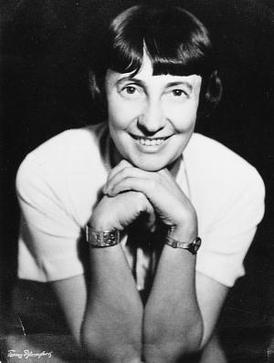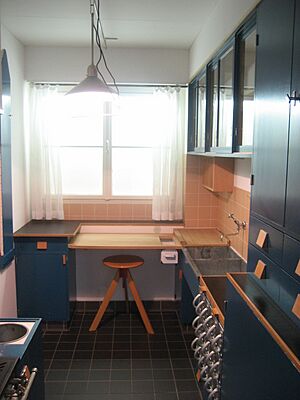Margarete Schütte-Lihotzky facts for kids
Quick facts for kids
Margarete Schütte-Lihotzky
|
|
|---|---|
 |
|
| Born | 23 January 1897 |
| Died | 18 January 2000 (aged 102) Vienna
|
| Nationality | Austrian |
| Alma mater | University of Applied Arts Vienna |
| Occupation | Architect |
| Spouse(s) | Wilhelm Schütte |
| Design | Frankfurt kitchen |
Margarete "Grete" Schütte-Lihotzky (born January 23, 1897 – died January 18, 2000) was an Austrian architect. She was also a brave activist who fought against the Nazis. Today, she is best known for designing the famous Frankfurt kitchen.
Contents
Early Life and Education
Margarete Lihotzky was born in Vienna, Austria, on January 23, 1897. Her family was well-off. Her father was a civil servant who believed in peace. He was happy when the old empire ended and a new republic began in 1918.
Margarete made history by becoming the first female student to study architecture at the Kunstgewerbeschule. This school is now called the University of Applied Arts Vienna. Famous artists taught there, like Josef Hoffmann and Oskar Kokoschka. Margarete almost didn't get in. Her mother even asked the famous artist Gustav Klimt for a letter to help her.
In 1997, when she turned 100, Margarete looked back at her decision to study architecture. She said that in 1916, "no one would have thought a woman could be hired to build a house – not even myself."
Margarete studied architecture with Oskar Strnad. She won awards for her designs even before she finished school. Strnad was a leader in building affordable homes for working families in Vienna. He taught Margarete that good design should also be useful. This idea became very important in her work.
After graduating, Margarete worked on many projects. She helped design homes for soldiers who had been injured in World War I. She also worked with other architects and thinkers. She wrote a book called Warum ich Architektin wurde, which means 'Why I Became an Architect'. In it, she shared her memories of these times.
Designing Homes for Everyone
In 1926, Margarete was invited to work in Frankfurt am Main, Germany. She joined a team led by architect Ernst May. They were working on a big project called New Frankfurt. The goal was to solve the city's housing shortage.
Ernst May had the power and money to build many new homes. Margarete and the team made sure these homes were practical and comfortable for thousands of families. They focused on clear, useful designs.
Margarete also designed buildings for communities. She created plans for kindergartens, student homes, and schools. Her kindergarten designs were based on the ideas of Maria Montessori. In Frankfurt, she met another architect, Wilhelm Schütte. They got married the next year.
The Famous Frankfurt Kitchen
One of Margarete's most famous designs was the Frankfurt kitchen, created in 1926. This kitchen was a model for the built-in kitchens we see everywhere today. She studied how kitchens worked, even looking at train dining cars.
Margarete designed the kitchen to be like a "housewife's laboratory." It used very little space (just 1.9 x 3.4 meters) but had everything needed for cooking. The kitchen surfaces were painted blue-green because people thought that color kept flies away. The city of Frankfurt installed 10,000 of these kitchens in new apartments for working-class families. They were built in factories and then put into the homes.
On her 100th birthday, Margarete joked about her famous kitchen. She said, "You'll be surprised that, before I designed the Frankfurt Kitchen in 1926, I never cooked myself." She designed it as an architect, not as someone who cooked every day.
During World War II
As the political situation in Germany became difficult, Margarete joined a team of architects called the "May Brigade." In 1930, they traveled to Moscow, Russia. They were asked to help build a new industrial city called Magnitogorsk. When they arrived, it was mostly mud huts. The city was meant to grow to 200,000 people, mostly working in the steel industry.
The May Brigade helped build many cities. But life in Russia became very hard and dangerous. Margarete and her husband left in 1937. They moved to London, then to Paris. In 1933, Margarete also showed some of her work at a world's fair in Chicago.
In 1938, Margarete and her husband moved to Istanbul, Turkey. She taught at the Academy of Fine Arts there. Istanbul was a safe place for many Europeans escaping the war.
In Istanbul, Margarete met Herbert Eichholzer, another Austrian architect. He was organizing a secret group to resist the Nazi government. In 1939, Margarete joined the Austrian Communist Party. In December 1940, she bravely returned to Vienna to help the resistance movement.
On January 22, 1941, just 25 days after she arrived, Margarete was arrested by the Gestapo (the Nazi secret police). Other resistance fighters were also caught and later executed. Margarete was sentenced to 15 years in prison. She was freed by American soldiers on April 29, 1945.
After the War
After the war, Margarete worked in Bulgaria. She returned to Vienna in 1947. Because of her strong political beliefs, she didn't get many big building projects in Austria. Even though many buildings needed to be rebuilt, she mostly designed private homes. She also worked as a consultant in China, Cuba, and East Germany. In 1951, she and her husband separated.
Later in her life, Margarete's achievements were finally recognized in Austria. She first received awards for her peace work and for her brave actions in the resistance. In 1980, she received the Architecture Award from the City of Vienna. In 1985, she wrote her memories in a book called Erinnerungen aus dem Widerstand ('Memories From the Resistance').
In 1988, she refused an award from the Austrian President, Kurt Waldheim, because of his past actions during the war. She eventually accepted the award in 1992.
In 1990, a model of her Frankfurt Kitchen was put on display in a museum in Vienna.
Margarete celebrated her 100th birthday in 1997. She even danced a short waltz with the Mayor of Vienna. She joked that she would have liked to design a house for a rich person for a change.
Margarete Schütte-Lihotzky died in Vienna on January 18, 2000, just five days before her 103rd birthday. She passed away from complications after getting influenza. She was buried in the Vienna Central Cemetery.
Her life has inspired artists. The Australian writer Robyn Archer wrote a play about Margarete's life called Architektin. A band called Rotifer also wrote a song called "The Frankfurt Kitchen" to honor her work.
Honours and Awards
- Architecture Award of the City of Vienna (1980)
- Austrian Decoration for Science and Art (1992)
- Grand Decoration of Honour in Gold with Star for Services to the Republic of Austria (1997)
See also
 In Spanish: Margarete Schütte-Lihotzky para niños
In Spanish: Margarete Schütte-Lihotzky para niños




